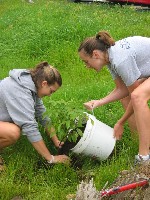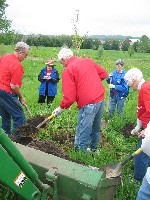News & Events
All That Stuff
Posted on Monday, September 22, 2008
"What do you DO with all that stuff?" is the predictable question when newcomers to the Field Station see the five long rows of compost and hear that we handle over 200 tons of compostables each year.
Some folks prefer ignorance to knowing about the "stuff" that goes into making good compost. Others recoil at even the thought of the squishy leftover food and stable waste that are essential to the nutrient content of good compost. But others (and that number is growing) get really excited about turning castaways into dirt! We call the stuff "feedstocks" and they are classified as "greens," high in nitrogen or "browns," high in carbon. One way or another, many people in the community and college are coming to see as beautiful the process that manages microorganisms as they convert repugnant stuff into a high quality soil conditioner . . . after only four or five months of stirring together the "greens " and "browns."
Modern-day composting is a venture that is far more sophisticated (and satisfying) than just placing "stuff" out to rot! Composting facilities, like the three-year DEP-funded project at Westminster's Field Station, effectively divert low quality resources like food and yard waste to create high quality, nutrient rich compost. This form of recycling closes the loop on waste. I regularly tell college students and adults, "If you aren't involved in composting now you had better learn about it soon because this is definitely the way we must handle biodegradable wastes. Landfilling them is not the proper answer. These wastes store tremendous amounts of energy and have valuable qualities that deserve a "second life" if we let them."
After combining an equal volume of "greens" (stable waste, food waste, pondweed and grass clippings) and "browns" (leaves, shredded paper and chipped branches) into rows that stand nearly four feet high and extend 50 yards, we stirr, stirr, stirr! This is done with a machine attached to a 50-hp tractor. When stirred weekly and watered when necessary, this mix of feedstocks slowly but surely is converted by microorganisms into a malleable "black gold." Regular chemical tests provide data on the changes that take place. The process of conversion is initially anaerobic (in the absence of oxygen, acids are produced that make for a low pH) and as stirring mixes in oxygen, the microorganisms switch their metabolism to aerobic, thus neutralizing the acids. The resulting compost is generally in the pH range of 6.8 to 7.2 -- virtually neutral. The nitrogen, phosphorus and other inorganic ions in the compost are there to be passed along to plants. The undigested residue of carbon compounds aid water retention of soil.
Let's look at the big picture of the need to compost on a massive scale, not just for our region but for our nation (and even the world). Here are some numbers. According to the U.S. Environmental Protection Agency, 251.3 million tons of municipal solid waste (MSW) were generated in the United States during 2006 (the latest year for which data are available). This is an increase of 13 million tons from 2000. For comparison, in 1960 only 88.1 million tons of MSW were generated. The National Solid Waste Management Association estimates that paper and paperboard products are the largest component in the trash we generate (33.9%) followed by yard trimmings (12.9%), food waste (12.4%), plastic (11.7%), metals (7.6%), wood (5.5%), glass (5.3 %), textiles (4.7%). rubber and leather (2.6%) and other materials (3.4%). Approximately 10% of that amount is recycled, 10% is burned, and the remaining 80% is landfilled! Go back and re-read those numbers!
In the United States, we generate 3 to 5 pounds of MSW per person per day. Is there suddenly a problem? Years ago everything appeared to be taken care of -- garbage was put out for haulers and it was taken away ("out of sight, out of mind"). Only the naive fail to see that our problem has been accumulating for a long time. We must reeducate ourselves to realize that waste is a resource that can and must be managed.
Furthermore, the EPA predicts that 80% of the existing landfills that operate with a government permit will close within 20 years. There are many reasons we are losing our landfill space. Older landfills are filling up, federal, state, and local restrictions are becoming stricter, and there is greater public opposition to opening any new facilities. The cliché is, "Not in MY backyard."
Hi-tech composting operations of the future will need to handle mega-tons of waste in small and even major cities of our country. Seattle, Washington is a leader in this venture. Sophistication of the process, in addition to efficiently producing valuable compost, will lead to the recovery of two forms of energy from composting that we, at the Field Station, are currently unable to capture: heat produced by the microorganisms that could be used for homes and industry and methane (natural gas) generated by microorganisms that is a valued fuel.
College students and the general public must learn how composting happens and will impact all our lives! We have "lots of stuff" to do something with and we had jolly well better start NOW!
So, to answer the inevitable question about our composting operation at the Field Station, here is what we DO with all our stuff. The top priorities are to take care of tree and shrubbery planting and nurturing at Westminster College. I offer two of many possible examples.
We plant trees in an plot at the Field Station that we are using to reconstruct a small woodlot that would likely have been in our region prior to 1795 when European settlement was beginning. We call this a Microforest and these native trees are called "witness trees." They are going to show generations yet unborn what was here . . . and then disappeared . . . as our ancestors took over the land of Penn's Woods from the Native Americans. Compost that we use in abundance helps those seedlings off to a good start and continues to nurture them until they are independent!
A second example of applied compost happened on Saturday, September 6. Several loads of compost were used in a college - community project that planted 150 silky dogwoods and elderberry shrubs along McClure Run, the stream that traverses the campus and the borough. Over 50 friends of the environment turned out to plant and see the shrubs off to a good start with generous doses of compost. Later this fall, tree seedlings will be planted, using compost, along the stream that has just been restored. The project was a cooperative effort of Westminster; the Lawrence County Commissioners, Planning Department, and the Conservation District, who helped secure funding; and Wallace and Pancher, the design-build firm in Hermitage, that contracted the restoration.
After the needs for compost by the college have been satisfied, and if we have excess, we are now selling the "black gold." We will still supply the local boroughs, churches and garden clubs with compost at no charge. Individuals and businesses may call 724-946-8520 to arrange for pick up of tested and screened compost at a reasonable price. We are making a difference!
Clarence Harms, Director
Field Station



More Stories



